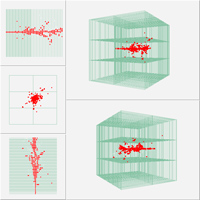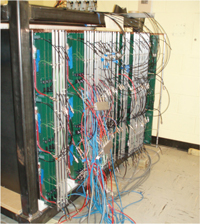 |
 |
|||||||||||||
|
|||||||||||||
|
|||||||||||||
|
Scientists led by a group at Argonne National Laboratory are bringing pictures of hadronic showers into sharper focus with the Digital Hadron Calorimeter, or DHCAL, one of several hadron calorimeter options for the ILC detector. The Argonne group began testing the device last month at the Fermilab Test Beam Facility. The new particle detector makes use of numerous binary signals to deliver what could be the finest image yet of showers induced by hadronic particles.
“Nobody has ever measured hadron showers with such great detail before,” said scientist José Repond, who leads the DHCAL team. Enhanced detail of particle showers allows researchers to measure individual particles in a hadronic jet. This is particularly important for the application of particle flow algorithms to the measurement of the jets' energy. “The essential thing for the particle flow algorithm to work is that you can separate individual showers even when they're pretty close together,” said Argonne scientist Lei Xia. “If you have a detailed view of the showers, you have a chance to separate them.” An imaging calorimeter such as the DHCAL is made of dozens of alternating layers of an absorbing material, an active element and readout boards with sensor pads arranged in a grid. Hadron showers are created when a high-energy particle interacts with the absorber. Each sensory pad takes a close look at a small area of the resulting showers, recording their signatures. The detector tabulates all the information from all the sensors, so recreating the shape of the shower and summing the shower's total energy. In the case of DHCAL, layers of steel alternate with resistive plate chambers, or RPCs, as active elements. Particles traverse the RPCs and ionise the gas inside them, creating a small avalanche, which can be detected with the sensory pads. DHCAL's pointillistic approach to rendering the shower shape sets it apart from other comparable calorimeters. It employs a high density of the smallest sensory cells yet devised for such a detector. Just as the many smaller pixels in a screen monitor create an image of greater detail, so do the many smaller sensors create a more detailed readout of a particle shower. Each DHCAL sensor is only 2 to 3 cubic centimetres – more than 1,000 times smaller than the sensor cells in non-imaging detectors. Scientists have packed 350,000 of these tiny cells into the refrigerator-sized DHCAL prototype. That's as many channels as are found in the 16 thousand-cubic metre future NOvA neutrino detector. “The NOvA detector is an enormous monster, but all our sensory channels are in one cubic metre,” said Xia. Because of the fine segmentation of the readout, DHCAL also approaches the energy calculation differently from other calorimeters. Rather than report how much energy a sensor detects, as is traditionally done, each DHCAL sensor simply reports whether or not energy is deposited. “DHCAL gives a yes-or-no answer on oodles of channels,” said Repond. That yes-or-no response means that the total energy is calculated simply by tallying all the "yes" responses to the question: "Did a particle pass through here?" “With our approach, we just count the number of cells being hit,” said Xia. “Since we have so many cells, that's a pretty good measure of the energy.” Though this binary method may seem as if it would lead to imprecise measurements, simulations show that the resulting energy resolution is comparable to the traditional approach. And with the finer granularity afforded by all the minuscule readout pads, the DHCAL's spatial resolution is several orders of magnitude better than that of previous calorimeters. The DHCAL programme is part of the worldwide Calorimeter for the Linear Collider Experiment (CALICE) collaboration, which coordinates detector development efforts to better resolve particle showers. DHCAL collaborators include researchers at Argonne National Laboratory, Boston University, Fermilab, IHEP in Beijing, University of Iowa, McGill University, Northwestern University and the University of Texas at Arlington. “We'll have to see how the DHCAL behaves, if it is useful as a calorimeter and if it gives us the response we're hoping for,” said Repond. “Actually, we're pretty optimistic that it will.” The DHCAL team will continue their tests throughout 2011. -- Leah Hesla |
|||||||||||||
| © International Linear Collider |

